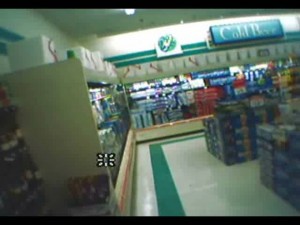Scott Young
Marketers are increasingly recognising the importance of “winning at retail” and influencing the many purchase decisions made in store. In their race to better understand and impact the shopping experience, most companies have quickly learned that observation is the key to shopper research, as there is often a wide gap between “what shoppers say” and “what shoppers do.” Asking questions often drives misleading conclusions; shoppers honestly don’t know how and why they made decisions. Given the overwhelming amount of stimuli in-store, their thought processes can’t be fully rational. Instead, in-store decisions are largely physiological. They are driven by what shoppers see (and miss) in their trips down the aisle.
This reality led Perception Research Services (PRS) to explore bringing its eye-tracking technology, which PRS pioneered over 35 years ago in central location testing, to actual stores. This new form of eye-tracking (PRS Mobile Eye-Tracking) takes the form of a pair of glasses or a small visor, which creates a videotape of each person’s shopping experience (including his/her exact focal point) around the store and in the aisle. Importantly (and uniquely), this system provides accurate readings at all distances, which allows for documentation of both “macro-level” shopping behavior (such as aisle navigation and category viewing patterns) and more “micro-level” actions (such as readership of packaging and POP materials).
In this article, we’ll share highlights from three recent studies utilising PRS Mobile Eye-Tracking in retail stores. We’ll summarise specific learning from each study – and discuss how these findings link to larger underlying “shopping realities” that PRS has seen across studies, categories and countries. These examples will highlight the added-value that can be gained from eye-tracking.
1 – “Grab & Go” Shopping
Our initial case study involved a frequently-shopped food category: A grocery aisle that many people shop weekly or bi-weekly, as a staple of their diet.
Not surprisingly, our research across numerous retailers and 3 channels (grocery, mass and club stores) revealed a largely consistent pattern: Shoppers were on “auto-pilot” in the aisle. They typically spent under a minute in the aisle, grabbed a single product, and levels of observed comparison shopping were remarkably low (about 5%). Unfortunately, levels of incremental or unplanned purchases were similarly low, which limited profitability for both manufacturers and retailers.
![]() While some these findings were obvious through more traditional forms of observation, the eye-tracking revealed a deeper and highly actionable insight. The fact that shoppers were frequently buying the brand they saw first. In other words, shopping in this aisle was not necessarily a matter of people finding “their brand” and putting it in the cart. Instead, shoppers were selecting the first brand (presumably within a set of “acceptable” brands) that met their primary criteria (flavor, form).
While some these findings were obvious through more traditional forms of observation, the eye-tracking revealed a deeper and highly actionable insight. The fact that shoppers were frequently buying the brand they saw first. In other words, shopping in this aisle was not necessarily a matter of people finding “their brand” and putting it in the cart. Instead, shoppers were selecting the first brand (presumably within a set of “acceptable” brands) that met their primary criteria (flavor, form).
For many years, we’ve known and preached that retail visibility, “Stopping Power”, is a key driver of success. However, this study took that learning further, by suggesting that pre-empting competition, via displays, strategic shelving and breakthrough packaging is critical, particularly in habitual “grab-and-go” categories.
Of course, this study also ties to a more universal shopping reality, the burden of too much choice. As categories continue to expand, shoppers everywhere are overwhelmed at the shelf. With hundreds of choices to consider, they instead tune out and default to the familiar or the first brand seen, to save both time and aggravation. As a result, it becomes ever harder for new products to succeed – and for marketers to drive incremental purchases. Indeed, in this particular study, it was telling that we saw the highest degree of unplanned purchases (and comparison shopping) in the Club channel, where the category was far less complex (with larger packages and fewer options).
2 – High-Involvement Purchases
A second study focused on a very different category and shopping experience. A consumer electronics product that was purchased infrequently and required more information and a larger investment.
Here, our research across several countries (the U.S., China and Western Europe) and multiple retail channels focused on a different dynamic: The role of various marketing vehicles and materials along the “path to purchase.” As with the earlier example, some findings were quite predictable, most notably the significant role of pre-planning (Internet-based research, publicised discounts, etc.) in influencing or “framing” the shopping trip. However, even in cases of extensive pre-planning, in-store observation confirmed that these shoppers were comparing products and making decisions in the aisle.
In this case, the eye-tracking documented engagement with different vehicles (packaging, product displays and point-of-sale signage/materials) within the in-store discrimination process. Specifically, we found that, when physical product displays were available (typically in computer superstores) they were nearly always the initial source of attention – and the primary driver of decisions. In these situations, POS displays and packaging were generally regulated to a supporting role (confirming specifications, compatibility, etc.). Meanwhile, in channels without product displays, shoppers typically relied on packaging (rather than POS materials) to compare products.
In fact, we uncovered that shoppers’ engagement with different types of POS varied widely. While some materials

(most notably those with unique shapes and appearance) were regularly part of the shopping process, many other forms were consistently ignored – and most likely represented a waste of resources. The primary implication – that it is better to limit and focus in-store merchandising efforts (less is more) – was quite clear and consistent with what we’ve seen in other studies (at quick-service restaurants, convenience stores and other retail channels).
Observing these technology shoppers also illustrated a larger shopping reality, which we call the “Great Disconnect.” Across categories, we often find that shoppers come to the shelf thinking in terms of users and usage occasions (will this product serve my specific need?). In the aisle, however, they frequently encounter a bewildering range of choices that emphasise product forms, features, benefits or sub-brands. Point-of-sale materials that help bridge this gap – by linking features/benefits to users and usage occasion – are often the most successful in closing sale and driving incremental purchases.
3 – Stopping Power & Emotional Connection
A third study also centered on in-store signage and displays, but in the very different context of a popular beverage aisle (in North America and South America). In this heavily-merchandised category, the primary objective was to understand which POP materials were consistently seen and which were ignored. In addition, we linked eye-tracking to neuroscience measures, to uncover which efforts drove cognitive engagement and a positive emotional reaction.
In this case, the findings highlighted the critical role of store placement – and the fact that the location of merchandising can actually be more important than the creative execution. Without question, the clearest and most dramatic learning was that ceiling-based signage was completely ignored: Across dozens of eye-tracking videos, across countries and multiple stores, we did not see a single shopper look upward to engage with overhead promotional signage. This finding is largely consistent with our experience across studies and retail channels. Shoppers may use ceiling-based materials to guide store navigation, but once they are in the aisle, their focus is straight ahead or slightly downward. Thus, point-of-sale materials at eye-level or arm-level (interspersed with packages) are far more visually impactful than materials above the products.
In addition, the study revealed an interesting disconnect between retail visibility and emotional resonance. In fact, several of the ceiling-based signs (which were completely missed by shoppers) were actually among the most emotionally compelling to shoppers (when they later saw them upon forced exposure). Conversely, some of the most visible displays were not particularly compelling. The implication – and larger reality – is that shoppers aren’t consciously choosing what to look at in store. Instead, stopping power and in-store visibility is primarily a function of location/placement and contrast with the surrounding environment – and we shouldn’t assume that the most compelling displays will be the most visible ones. Therefore, marketers should think of visibility and content as two separate (and equally important) drivers of in-store success. To drive sales, they need to optimise both creative execution and store placement.
Benefiting from In-Store Eye-Tracking
The case studies above illustrate two primary and proven applications of mobile eye-tracking:
- Understanding in-store shopping behaviour – Particularly the role of visibility within the path to purchase
- Guiding, assessing and enhancing point-of-sale merchandising – In terms of both creative execution and in-store positioning
In addition, they highlight a primary benefit of this new tool, which is its flexibility for use in nearly all retail environments (across countries, channels, etc.). Indeed, we’ve found it valuable in helping marketers identify opportunities and guide in-store marketing strategy for new or alternative retail channels, such as convenience, club stores and traditional trade/kiosks in developing markets.
Finally, we’ve found that PRS Mobile Eye-Tracking can add considerable value in both qualitative and quantitative shopper research studies:.
- In qualitative studies (with 15-20 shoppers), the shopper videotapes are a primary output, often illustrating an observed behaviour (such as shopper confusion or frustration) in a compelling and visceral manner.
- In quantitative studies (with 75 or more shoppers), the value often lies in documenting visibility of specific displays or POS materials, typically via numerical data.
Across applications, the commonality is that eye-tracking gives marketers a “shoppers’ eye” view of the retail world. In doing so, it provides them with a richer and more meaningful understanding of the shopping experience – and typically a greater appreciation for the clutter and complexity of the shopping environment.
For specific studies and brands, this level of insight typically leads to more effective execution of shopper marketing campaigns. Across studies and over the long term, this perspective is also impacting how companies think about in-store marketing – and accelerating the transition towards strategies based on observed shopper behavior (“what shoppers do”), as opposed to what they say.
Scott Young is the president of Perception Research Services International


